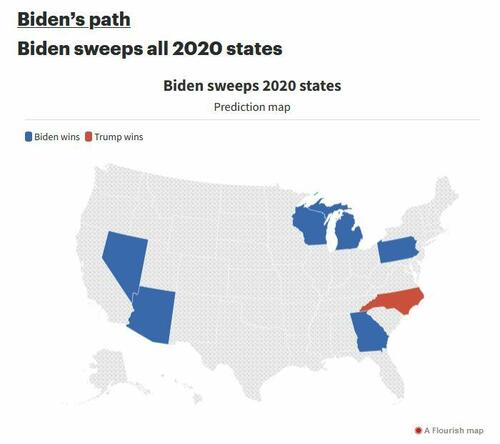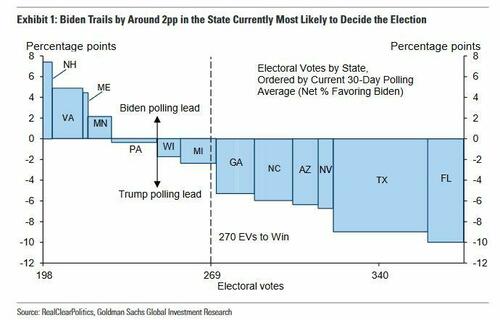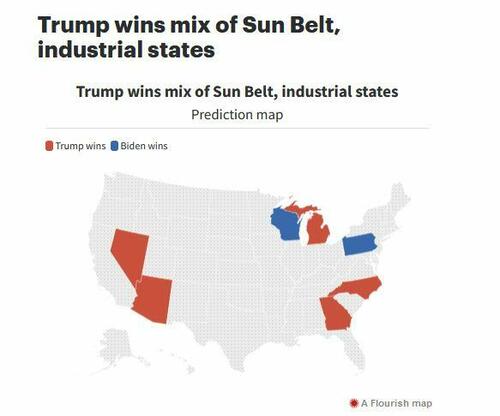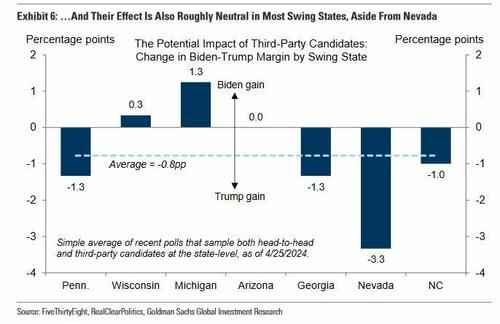
As the 2024 election approaches, a handful of swing states will actually determine the race. Here, we look at various paths to victory for both President Joe Biden and former President Donald Trump.
TL;DR - while national polls have Biden and Trump roughly tied - when it comes to the electoral college, Biden essentially has to win a 'blue wall' of states, plus one more electoral vote. For Trump - "If the election were held now and the polling with Trump ahead is correct in all seven states, Trump would defeat Biden comfortably in the Electoral College, 312 electoral votes to 226," The Hill reports. If Trump were to fall short in the two states where he and Biden are the closest, Pennsylvania and Wisconsin, Trump would still win, albeit by a much smaller margin.
Here's where things stand in the swing states according to Goldman - with Trump currently ahead according to RealClear Politics polling averages.
The most obvious path for Biden is the least likely - recreating his 2020 victory by winning the key battleground states of Arizona, Georgia, Michigan, Nevada, Pennsylvania and Wisconsin. This would put Biden at 303 electoral votes vs. 235 for Trump (270 are needed to win). That said, this seems unlikely - as there's never been two consecutive presidential elections in US history in which every states votes for the same party.

More realistically, Biden has cause for concern in several of the above states - such as Georgia, where Trump has maintained a consistent lead. That said, even if Trump takes Georgia, Arizona and Nevada, Biden could still win if he takes a trio of "blue wall" states - Michigan, Wisconsin and Pennsylvania - putting him at 269 electoral votes, and needing just one more from some other state to win. For example, both Nebraska and Maine distribute their electoral votes by congressional district vs. winner-take-all in other states.
Maine’s 2nd Congressional District has voted comfortably for Trump the past two elections, but Nebraska’s 2nd Congressional District narrowly voted for Trump in 2016 before flipping to Biden in 2020.
If Biden can hold on to just that congressional district along with the blue wall, he would not need any other state to be reelected, reaching the 270 threshold. -The Hill
Trump's Path:
Trump is firmly ahead of Biden in the polls, particularly in key states necessary for a winning coalition such as Arizona, Georgia, Michigan, Nevada and North Carolina - five of the seven battleground states that are expected to decide the election.
Again, as The Hill notes, "If the election were held now and the polling with Trump ahead is correct in all seven states, Trump would defeat Biden comfortably in the Electoral College, 312 electoral votes to 226."
That said, it Trump fell short in the two states where he and Biden are very close - Pennsylvania and Wisconsin, the former president would still win, though by much more narrow margin of 283 to 255.
Back to Goldman - recent polling on third party candidates may explain why Trump just went on the offensive against RFK, Jr. - as third party candidates are no longer drawing more from Biden than Trump in national polls.
In swing states, their effect is now roughly neutral aside from Nevada.
Yes, we know. None of this matters if Trump can't overcome the so-called 'margin of cheating.'
As the 2024 election approaches, a handful of swing states will actually determine the race. Here, we look at various paths to victory for both President Joe Biden and former President Donald Trump.
TL;DR – while national polls have Biden and Trump roughly tied – when it comes to the electoral college, Biden essentially has to win a ‘blue wall’ of states, plus one more electoral vote. For Trump – “If the election were held now and the polling with Trump ahead is correct in all seven states, Trump would defeat Biden comfortably in the Electoral College, 312 electoral votes to 226,” The Hill reports. If Trump were to fall short in the two states where he and Biden are the closest, Pennsylvania and Wisconsin, Trump would still win, albeit by a much smaller margin.
Here’s where things stand in the swing states according to Goldman – with Trump currently ahead according to RealClear Politics polling averages.
The most obvious path for Biden is the least likely – recreating his 2020 victory by winning the key battleground states of Arizona, Georgia, Michigan, Nevada, Pennsylvania and Wisconsin. This would put Biden at 303 electoral votes vs. 235 for Trump (270 are needed to win). That said, this seems unlikely – as there’s never been two consecutive presidential elections in US history in which every states votes for the same party.

More realistically, Biden has cause for concern in several of the above states – such as Georgia, where Trump has maintained a consistent lead. That said, even if Trump takes Georgia, Arizona and Nevada, Biden could still win if he takes a trio of “blue wall” states – Michigan, Wisconsin and Pennsylvania – putting him at 269 electoral votes, and needing just one more from some other state to win. For example, both Nebraska and Maine distribute their electoral votes by congressional district vs. winner-take-all in other states.
Maine’s 2nd Congressional District has voted comfortably for Trump the past two elections, but Nebraska’s 2nd Congressional District narrowly voted for Trump in 2016 before flipping to Biden in 2020.
If Biden can hold on to just that congressional district along with the blue wall, he would not need any other state to be reelected, reaching the 270 threshold. -The Hill
Trump’s Path:
Trump is firmly ahead of Biden in the polls, particularly in key states necessary for a winning coalition such as Arizona, Georgia, Michigan, Nevada and North Carolina – five of the seven battleground states that are expected to decide the election.
Again, as The Hill notes, “If the election were held now and the polling with Trump ahead is correct in all seven states, Trump would defeat Biden comfortably in the Electoral College, 312 electoral votes to 226.”
That said, it Trump fell short in the two states where he and Biden are very close – Pennsylvania and Wisconsin, the former president would still win, though by much more narrow margin of 283 to 255.
Back to Goldman – recent polling on third party candidates may explain why Trump just went on the offensive against RFK, Jr. – as third party candidates are no longer drawing more from Biden than Trump in national polls.
In swing states, their effect is now roughly neutral aside from Nevada.
Yes, we know. None of this matters if Trump can’t overcome the so-called ‘margin of cheating.’
Loading…










